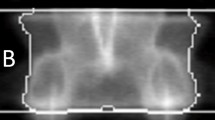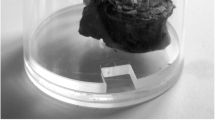Abstract
Summary
We investigated the association of trabecular bone score (TBS) with microarchitecture and mechanical behavior of human lumbar vertebrae. We found that TBS reflects vertebral trabecular microarchitecture and is an independent predictor of vertebral mechanics. However, the addition of TBS to areal BMD (aBMD) did not significantly improve prediction of vertebral strength.
Introduction
The trabecular bone score (TBS) is a gray-level measure of texture using a modified experimental variogram which can be extracted from dual-energy X-ray absorptiometry (DXA) images. The current study aimed to confirm whether TBS is associated with trabecular microarchitecture and mechanics of human lumbar vertebrae, and if its combination with BMD improves prediction of fracture risk.
Methods
Lumbar vertebrae (L3) were harvested fresh from 16 donors. The anteroposterior and lateral bone mineral content (BMC) and areal BMD (aBMD) of the vertebral body were measured using DXA; then, the TBS was extracted using TBS iNsight software (Medimaps SA, France). The trabecular bone volume (Tb.BV/tissue volume, TV), trabecular thickness (Tb.Th), degree of anisotropy, and structure model index (SMI) were measured using microcomputed tomography. Quasi-static uniaxial compressive testing was performed on L3 vertebral bodies to assess failure load and stiffness.
Results
The TBS was significantly correlated to Tb.BV/TV and SMI (r = 0.58 and −0.62; p = 0.02, 0.01), but not related to BMC and BMD. TBS was significantly correlated with stiffness (r = 0.64; p = 0.007), independently of bone mass. Using stepwise multiple regression models, we failed to demonstrate that the combination of BMD and TBS was better at explaining mechanical behavior than either variable alone. However, the combination TBS, Tb.Th, and BMC did perform better than each parameter alone, explaining 79 % of the variability in stiffness.
Conclusions
In our study, TBS was associated with microarchitecture parameters and with vertebral mechanical behavior, but TBS did not improve prediction of vertebral biomechanical properties in addition to aBMD.


Similar content being viewed by others
References
Roux JP, Wegrzyn J, Arlot ME, Guyen O, Chapurlat R, Bouxsein ML (2010) Contribution of trabecular and cortical components to biomechanical behavior of human vertebrae. An ex-vivo study. J Bone Miner Res 25(2):356–361
Wegrzyn J, Roux JP, Arlot ME, Stéphanie B, Nicolas V, Guyen O, Chapurlat R, Bouxsein ML (2010) Role of trabecular microarchitecture and its heterogeneity parameters in the mechanical behavior of ex-vivo human L3 vertebrae. J Bone Miner Res 25(11):2324–2331
Sornay-Rendu E, Boutroy S, Munoz F, Delmas PD (2007) Alterations of cortical and trabecular architecture are associated with fractures in postmenopausal women, partially independent of decreased BMD measured by DXA: the OFELY study. J Bone Miner Res 22(3):425–433
Boutroy S, Van Rietbergen B, Sornay-Rendu E, Munoz F, Bouxsein ML, Delmas PD (2008) Finite element analysis based on in vivo HR-pQCT images of the distal radius is associated with wrist fracture in postmenopausal women. J Bone Miner Res 23(3):392–399
Vilayphiou N, Boutroy S, Sornay-Rendu E, Van Rietbergen B, Munoz F, Delmas PD, Chapurlat R (2010) Finite element analysis performed on radius and tibia HR-pQCT images and fragility fractures at all sites in postmenopausal women. Bone 46(4):1030–1037
Hans D, Goertzen AL, Krieg MA, Leslie WD (2011) Bone microarchitecture assessed by TBS predicts osteoporotic fractures independent of bone density: the Manitoba study. J Bone Miner Res 26(11):2762–2769
Hans D, Barthe N, Boutroy S, Pothuaud L, Winzenrieth R, Krieg MA (2011) Correlations between trabecular bone score, measured using anteroposterior dual-energy X-ray absorptiometry acquisition, and 3-dimensional parameters of bone microarchitecture: an experimental study on human cadaver vertebrae. J Clin Densitom 14(3):302–312
Pothuaud L, Barthe N, Krieg MA, Mehsen N, Carceller P, Hans D (2009) Evaluation of the potential use of trabecular bone score to complement bone mineral density in the diagnosis of osteoporosis: a preliminary spine BMD-matched, case–control study. J Clin Densitom 12(2):170–176
Winzenrieth R, Dufour R, Pothuaud L, Hans D (2010) A retrospective case–control study assessing the role of trabecular bone score in postmenopausal Caucasian women with osteopenia: analyzing the odds of vertebral fracture. Calcif Tissue Int 86(2):104–109
Bousson V, Bergot C, Sutter B, Levitz P, Cortet B (2012) Trabecular bone score (TBS): available knowledge, clinical relevance, and future prospects. Osteoporos Int 23(5):1489–1501
Martin RB, Sharkey NA (2001) Mechanical effects of post-mortem changes, preservation, and allograft bone treatments. In: Cowin SC (ed) Bone mechanics handbook, 2nd edn. CRC Press, Boca Raton, pp 20.1–20.24
Ashman RB, Donofrio M, Cowin SC, van Buskirk WC (1982) Postmortem changes in the elastic properties of trabecular bone. Trans Orthop Res Soc 7:63–67
Cheng XG, Nicholson PH, Boonen S, Lowet G, Brys P, Aerssens J, Van der Perre G, Dequeker J (1997) Prediction of vertebral strength in vitro by spinal bone densitometry and calcaneal ultrasound. J Bone Miner Res 12(10):1721–1728
Pothuaud L, Carceller P, Hans D (2008) Correlations between grey-level variations in 2D projection images (TBS) and 3D microarchitecture: applications in the study of human trabecular bone microarchitecture. Bone 42(4):775–787
Bouxsein ML, Boyd SK, Christiansen BA, Guldberg RE, Jepsen KJ, Müller R (2010) Guidelines for assessment of bone microstructure in rodents using micro-computed tomography. J Bone Miner Res 25(7):1468–1486
Hildebrand T, Rüegsegger P (1997) Quantification of bone microarchitecture with the structure model index. Comput Meth Biomech Biomed Engin 1(1):15–23
Winzenrieth R, Michelet F, Hans D (2013) Three-dimensional (3D) microarchitecture correlations with 2D projection image gray-level variations assessed by trabecular bone score using high-resolution computed tomographic acquisitions: effects of resolution and noise. J Clin Densitom (in press)
Rabier B, Héraud A, Grand-Lenoir C, Winzenrieth R, Hans D (2010) A multicentre, retrospective case–control study assessing the role of trabecular bone score (TBS) in menopausal Caucasian women with low areal bone mineral density (BMDa): analysing the odds of vertebral fracture. Bone 46(1):176–181
Boutroy S, Hans D, Sornay-Rendu E, Vilayphiou N, Winzenrieth R, Chapurlat R (2013) Trabecular bone score improves fracture risk prediction in non-osteoporotic women: the OFELY study. Osteoporos Int 24(1):77–85
Lespessailles E, Roux JP, Benhamou CL, Arlot ME, Eynard E, Harba R, Padonou C, Meunier PJ (1998) Fractal analysis of bone texture on os calcis radiographs compared with trabecular microarchitecture analyzed by histomorphometry. Calcif Tissue Int 63(2):121–125
Kolta S, Paratte S, Amphoux T, Persohn S, Campana S, Skalli W, Paternotte S, Argenson JN, Bouler JM, Gagey O, Roux C (2012) Bone texture analysis of human femurs using a new device (BMA™) improves failure load prediction. Osteoporos Int 23(4):1311–1316
Le Corroller T, Halgrin J, Pithioux M, Guenoun D, Chabrand P, Champsaur P (2012) Combination of texture analysis and bone mineral density improves the prediction of fracture load in human femurs. Osteoporos Int 23(1):163–169
Pothuaud L, Lespessailles E, Harba R, Jennane R, Royant V, Eynard E, Benhamou CL (1998) Fractal analysis of trabecular bone texture on radiographs: discriminant value in postmenopausal osteoporosis. Osteoporos Int 8(6):618–625
Lespessailles E, Gadois C, Kousignian I, Neveu JP, Fardellone P, Kolta S, Roux C, Do-Huu JP, Benhamou CL (2008) Clinical interest of bone texture analysis in osteoporosis: a case control multicenter study. Osteoporos Int 19(7):1019–1028
Ebbesen EN, Thomsen JS, Beck-Nielsen H, Nepper-Rasmussen HJ, Mosekilde L (1999) Lumbar vertebral body compressive strength evaluated by dual-energy X-ray absorptiometry, quantitative computed tomography, and ashing. Bone 25(6):713–724
Buckley JM, Loo K, Motherway J (2007) Comparison of quantitative computed tomography-based measures in predicting vertebral compressive strength. Bone 40(3):767–774
Duan Y, Seeman E, Turner CH (2001) The biomechanical basis of vertebral body fragility in men and women. J Bone Miner Res 16(12):2276–2283
Conflicts of interest
None.
Author information
Authors and Affiliations
Corresponding author
Additional information
J. P. Roux and J. Wegrzyn contributed equally to this work.
D. Hans is co-owner of the TBS patent and has corresponding ownership shares in Medimaps group.
Rights and permissions
About this article
Cite this article
Roux, J.P., Wegrzyn, J., Boutroy, S. et al. The predictive value of trabecular bone score (TBS) on whole lumbar vertebrae mechanics: an ex vivo study. Osteoporos Int 24, 2455–2460 (2013). https://doi.org/10.1007/s00198-013-2316-7
Received:
Accepted:
Published:
Issue Date:
DOI: https://doi.org/10.1007/s00198-013-2316-7




